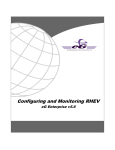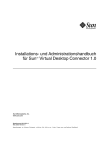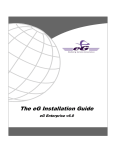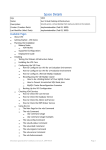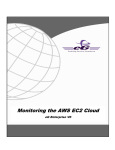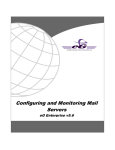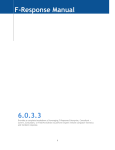Download Configuring and Monitoring Oracle VDI
Transcript
Configuring and Monitoring Oracle VDI eG Enterprise v5.6 Restricted Rights Legend The information contained in this document is confidential and subject to change without notice. No part of this document may be reproduced or disclosed to others without the prior permission of eG Innovations, Inc. eG Innovations, Inc. makes no warranty of any kind with regard to the software and documentation, including, but not limited to, the implied warranties of merchantability and fitness for a particular purpose. Trademarks Microsoft Windows, Windows NT, Windows 2000, Windows 2003 and Windows 2008 are either registered trademarks or trademarks of Microsoft Corporation in United States and/or other countries. The names of actual companies and products mentioned herein may be the trademarks of their respective owners. Copyright © 2012 eG Innovations, Inc. All rights reserved. Table of Contents CONFIGURING AND MONITORING THE ORACLE VIRTUALBOX...........................................................................................2 1.1 1.2 1.3 CHALLENGES IN MONITORING THE ORACLE VIRTUALBOX.............................................................................................................................. 3 EG'S SOLUTION TO ORACLE VIRTUALBOX MONITORING ................................................................................................................................. 4 AGENT DEPLOYMENT MODELS ......................................................................................................................................................................... 5 1.3.1 The Agent-based Monitoring Approach .............................................................................................................................................. 5 1.3.2 The Agentless Monitoring Approach................................................................................................................................................... 6 1.4 PRE-REQUISITES FOR MONITORING THE ORACLE VIRTUALBOX ...................................................................................................................... 7 1.4.1 Pre-requisites for Monitoring the Oracle VirtualBox in an Agent-based Manner............................................................................. 7 1.4.1.1 General Pre-requisites ............................................................................................................................................................ 7 1.4.1.2 Pre-requisites for Auto-Discovering VMs and Obtaining their "Outside View".................................................................. 7 1.4.1.3 Pre-requisites for Obtaining the "Inside View" of Windows VMs, using the eG VM Agent .............................................. 8 1.4.1.4 Pre-requisites for Obtaining the "Inside View" of VMs, without using the eG VM Agent ................................................. 8 1.4.2 Pre-requisites for Monitoring the Oracle VirtualBox in an Agentless Manner ................................................................................. 8 1.4.2.1 General Pre-requisites ............................................................................................................................................................ 8 1.4.2.2 Pre-requisites for Auto-Discovering VMs and Obtaining their "Outside View".................................................................. 8 1.4.2.3 Pre-requisites for Obtaining the "Inside View" of Windows VMs, using the eG VM Agent .............................................. 9 1.4.2.4 Pre-requisites for Obtaining the "Inside View" of VMs, without using the eG VM Agent ................................................. 9 1.5 CONFIGURING THE EG AGENT TO OBTAIN THE INSIDE VIEW OF WINDOWS VMS, USING THE EG VM AGENT ............................................ 10 1.5.1 Communication between the eG Agent and the eG VM Agent.......................................................................................................... 13 1.5.2 Licensing of the eG VM Agent ........................................................................................................................................................... 14 1.5.3 Benefits of the eG VM Agent.............................................................................................................................................................. 14 1.6 CONFIGURING WINDOWS VIRTUAL MACHINES TO SUPPORT THE EG AGENT’S INSIDE VIEW WITHOUT THE EG VM AGENT ..................... 14 1.6.1 Enabling ADMIN$ Share Access on Windows Virtual Guests ......................................................................................................... 15 1.6.1.1 Enabling ADMIN$ Share Access on Windows 2000/2003 VMs ....................................................................................... 15 1.6.1.2 Enabling ADMIN$ Share Access on Windows 2008 VMs ................................................................................................ 20 1.6.2 Configuring Windows Firewalls to Allow File and Print Sharing ................................................................................................... 24 1.7 ADMINISTERING THE EG MANAGER TO MONITOR THE ORACLE VIRTUALBOX ............................................................................................. 27 1.8 CONFIGURING USERS FOR VM MONITORING ................................................................................................................................................. 31 1.9 MONITORING THE ORACLE VIRTUALBOX ....................................................................................................................................................... 33 1.10 TROUBLESHOOTING THE FAILURE OF THE EG REMOTE AGENT TO CONNECT TO OR REPORT MEASURES FOR LINUX GUESTS ................... 33 CONFIGURING AND MONITORING THE ORACLE VDI BROKER ..........................................................................................37 2.1 2.2 2.3 2.4 PRE-REQUISITES FOR MONITORING THE ORACLE VDI BROKER IN AN AGENT-BASED MANNER .................................................................. 37 PRE-REQUISITES FOR MONITORING THE ORACLE VDI BROKER IN AN AGENTLESS MANNER ....................................................................... 38 ADMINISTERING THE EG MANAGER TO MONITOR AN ORACLE VDI BROKER ............................................................................................... 38 MONITORING THE ORACLE VDI BROKER........................................................................................................................................................ 40 CONCLUSION..........................................................................................................................................................................................41 Table of Figures Figure 1.1: Architecture of the Oracle Virtual Desktop Infrastructure ........................................................................................................2 Figure 1.2: Architecture of an Oracle VirtualBox ........................................................................................................................................3 Figure 1.3: The layer model of Oracle VirtualBox.......................................................................................................................................4 Figure 1.4: Agent-based monitoring of the Oracle VirtualBox....................................................................................................................5 Figure 1.5: The Agentless approach to monitoring the Oracle VirtualBox .................................................................................................6 Figure 1.6: Welcome screen of the eG VM Agent installation wizard ......................................................................................................11 Figure 1.7: Accepting the license agreement..............................................................................................................................................11 Figure 1.8: Specifying the install directory of the eG VM Agent ..............................................................................................................12 Figure 1.9: Specifying the VM agent port ..................................................................................................................................................12 Figure 1.10: A summary of your specifications .........................................................................................................................................13 Figure 1.11: Finishing the installation ........................................................................................................................................................13 Figure 1.12: The ADMIN$ share does not exist.........................................................................................................................................15 Figure 1.13: Admin$ share pre-exists.........................................................................................................................................................16 Figure 1.14: Creating the ADMIN$ share ..................................................................................................................................................16 Figure 1.15: Clicking the Add button .........................................................................................................................................................17 Figure 1.16: Selecting the administrative user to whom access rights are to be granted...........................................................................17 Figure 1.17: The administrator account granted access permissions .........................................................................................................18 Figure 1.18: Defining the Security settings for the ADMIN$ share ..........................................................................................................18 Figure 1.19: Adding the administrator account ..........................................................................................................................................19 Figure 1.20: The Administrator account in the Security list ......................................................................................................................19 Figure 1.21: Selecting the Share option from the shortcut menu ...............................................................................................................20 Figure 1.22: Cicking on Advanced Sharing ...............................................................................................................................................21 Figure 1.23: Enabling the ADMIN$ share..................................................................................................................................................21 Figure 1.24: Clicking on the Add button ....................................................................................................................................................22 Figure 1.25: Allowing a domain administrator to access the folder ..........................................................................................................22 Figure 1.26: Allowing full access to the local/domain administrator ........................................................................................................23 Figure 1.27: Applying the changes .............................................................................................................................................................23 Figure 1.28: Selecting the guest OS............................................................................................................................................................24 Figure 1.29: Opening the Windows Firewall .............................................................................................................................................25 Figure 1.30: The General tab of the Windows Firewall dialog box...........................................................................................................25 Figure 1.31: Deselecting the 'Don't allow exceptions' check box ..............................................................................................................26 Figure 1.32: Enabling 'File and Printer Sharing'.........................................................................................................................................26 Figure 1.33: Opening ports .........................................................................................................................................................................27 Figure 1.34: Adding the Oracle VirtualBox component ............................................................................................................................27 Figure 1.35: List of Unconfigured tests for the Oracle VirtualBox ...........................................................................................................28 Figure 1.36: Configuring the VM Status test..............................................................................................................................................28 Figure 1.37: The VM user configuration page ...........................................................................................................................................32 Figure 1.38: Adding another user ...............................................................................................................................................................32 Figure 1.39: Associating a single domain with different admin users .......................................................................................................33 Figure 2.1: Adding the Oracle VDI Broker in an agentless approach .......................................................................................................39 Figure 2.2: Adding the Oracle VDI Broker in an agent based approach ...................................................................................................39 Figure 2.3: List of Unconfigured tests for the Oracle VDI Broker ............................................................................................................40 Figure 2.4: Configuring the VDI Database Status test ...............................................................................................................................40 C o n f i g u r i n g a n d M o n i t o r i n g t h e O r a c l e V i r t u a l B o x Chapter 1 Configuring and Monitoring the Oracle VirtualBox Oracle VDI (Virtual Desktop Infrastructure) provides desktop virtualization to replace personal computers with virtual machines (VMs) on a server. Users can access these VMs though any RDP client, or through the web via Sun Secure Global Desktop (SGD). Oracle Virtual Desktop Infrastructure is made up of four main components: virtualization platform, session management (Oracle VDI Core), desktop access clients, and storage. Figure 1.1: Architecture of the Oracle Virtual Desktop Infrastructure The basis for the Oracle Virtual Desktop Infrastructure architecture is the virtualization platform. In addition to creating and storing virtual machines, the virtualization platform offers the core functionality needed for virtual desktop management such as starting, stopping, and snapshotting virtual machines. Oracle Virtual Desktop Infrastructure 3.2 supports Oracle VM VirtualBox (the Oracle VDI Hypervisor), VMware vCenter, Microsoft Hyper-V, and Microsoft Remote Desktop Services as virtualization platforms. Oracle VM VirtualBox is cross-platform x86 virtualization software that extends the power of your existing computers to run multiple operating systems, on the same hardware, at the same time, and alongside your existing applications. 2 C o n f i g u r i n g a n d M o n i t o r i n g t h e O r a c l e V i r t u a l B o x Oracle VM VirtualBox includes a hypervisor for the host platform, an application programming interface (API) and software development kit (SDK) for managing guest virtual machines, a command-line tool for managing guests locally, a web service for remote management of guests, a wizard-style graphical tool to manage guests, a graphical console for displaying guest applications on the local host, and a built-in Remote Desktop Protocol (RDP) server that provides complete access to a guest from a remote client. At the core is the hypervisor, implemented as a ring 0 (privileged) kernel service. Figure 1.2 shows the relationships between all of these components. Figure 1.2: Architecture of an Oracle VirtualBox The kernel service consists of a device driver named vboxsrv, which is responsible for tasks such as allocating physical memory for the guest virtual machine, and several loadable hypervisor modules for things like saving and restoring the guest process context when a host interrupt occurs, turning control over to the guest OS to begin execution, and deciding when VT-x or AMD-V events need to be handled. The hypervisor does not get involved with the details of the guest operating system scheduling. Instead, those tasks are handled completely by the guest during its execution. The entire guest is run as a single process on the host system and will run only when scheduled by the host. If they are present, an administrator can use host resource controls such as scheduling classes and CPU caps or reservations to give very predictable execution of the guest machine. Additional device drivers will be present to allow the guest machine access to other host resources such as disks, network controllers, and audio and USB devices. In reality, the hypervisor actually does little work. Rather, most of the interesting work in running the guest machine is done in the guest process. Thus the host's resource controls and scheduling methods can be used to control the guest machine behavior. In addition to the kernel modules, several processes on the host are used to support running guests. All of these processes are started automatically when needed. 1.1 Challenges in Monitoring the Oracle VirtualBox What makes monitoring an Oracle VDI infrastructure a challenge is the large number of virtual desktops that will typically be configured on the VirtualBoxes and the large number of users to 3 C o n f i g u r i n g a n d M o n i t o r i n g t h e O r a c l e V i r t u a l B o x the desktops. While it can be very difficult to keep track of which user is accessing which desktop on which VirtualBox, the live and automatic migration of desktops to other VirtualBoxes (if any) in the environment only compounds the problem. To make matters worse, the users to the VDI service demand from the virtual desktops the same quality of service that they are used to receiving from their physical desktops. This means, quick access, uninterrupted connectivity, and stable operations will be the criteria on which the user experience with the VDI service will be judged. Non-availability of a desktop when a user needs it, or slowdowns in desktop operations caused by a resource contention at the desktoplevel or at the host-level may result in a deluge of user complaints and a bevy of dissatisfied users. To avoid this, service desk should be able to: Continuously monitor the user activity to the virtual desktops operating on a VirtualBox; Know which user accessed the desktop on which VirtualBox at what time; Track the powered-on state of desktops; Study the resource usage patterns of the virtual desktops to nail the root-cause of resource contentions - is it owing to a resource-hungry desktop? or a resource-starved host?; Promptly alert users to potential resource drains on desktops or a sudden change in the desktop state, much before users notice the difference! 1.2 eG's Solution to Oracle VirtualBox Monitoring The specialized Oracle VirtualBox monitoring model addresses all the requirements outlined above and more! This 100%, web-based solution employs a single eG agent to perform detailed 'In-N-Out' monitoring of the virtual desktops operating on an Oracle VirtualBox. Figure 1.3: The layer model of Oracle VirtualBox The metrics collected by this eG agent report on the percentage of the Oracle VirtualBox host's resources that each of the VMs on the server are using - i.e., the relative loading of the guest VMs. This represents the view of how a guest VM and its applications are doing - from the “outside” - i.e., from outside the guest VM. In addition, the eG agent also connects to each guest VM that is currently powered on and determines the guest OS version, the name(s) of the users who are logged on, the applications they are accessing, and the resource usage of the applications running inside the 4 C o n f i g u r i n g a n d M o n i t o r i n g t h e O r a c l e V i r t u a l B o x guest (as seen from within the guest operating system). This represents the view from within the guest operating system - i.e., the “inside” view. In addition, the same agent can also track the critical processes running on the Oracle VirtualBox host and their resource usage, the network connection to the host, and the TCP connectivity of the host, and thus report on the overall health of the host. The agent is also capable of capturing and reporting on the live migration of desktops from one VirtualBox to another. Based on the monitoring approach chosen, you can deploy this eG agent on the VirtualBox itself or on any remote Windows/Linux/Solaris host in the environment. Section 1.3 discusses both these deployment models in detail. 1.3 Agent Deployment Models eG Enterprise allows administrators the flexibility to choose between the agent-based and agentless approaches to monitoring the Oracle VirtualBox. 1.3.1 The Agent-based Monitoring Approach The agent-based approach requires that the eG agent be installed on the host operating system of the VirtualBox. Since Oracle VDI comes bundled with an Oracle VirtualBox that runs an Oracle Solaris operating system, you need to install a Solaris eG agent on the host. To know how to install an eG agent on Solaris, refer to the eG Installation Guide. Figure 1.4: Agent-based monitoring of the Oracle VirtualBox This agent should then be configured to communicate with the Oracle VirtualBox via SSH and run privileged Virtual Desktop Access (VDA) commands on the Oracle VirtualBox to determine the health of the host, to discover the IP address and operating system of each of the guests on the host, and to report how each guest has utilized the host's physical resources (i.e., outside view). For connecting to the target Oracle VirtualBox via SSH, the eG agent has to be configured with the credentials of a user with the required privileges. Also, to enable the eG agent to run VDA commands on the host, a sudo package has to be installed on the VirtualBox. To know how, refer to Section 1.4 below. Once the guests are discovered, the eG agent remotely communicates with each guest using SSH/WMI (depending upon the operating system of the guest) to obtain the "inside view" of every guest. To establish this remote connection with Windows VMs in particular, eG Enterprise requires that the eG agent be configured with domain administrator privileges. In 5 C o n f i g u r i n g a n d M o n i t o r i n g t h e O r a c l e V i r t u a l B o x high-security environments, where the IT staff might have reservations about exposing the credentials of their domain administrators, this approach to extracting “inside view” metrics might not be preferred. In such environments therefore, eG Enterprise provides administrators the option to deploy a piece of software called the eG VM Agent on every Windows VM, which allows the eG agent on the service console to collect “inside view” metrics from the VMs without domain administrator rights. Refer to Section 1.5 for more details on the eG VM Agent. 1.3.2 The Agentless Monitoring Approach The agentless approach to monitoring the Oracle VirtualBox involves the following: Deploying the eG agent on a remote system running Microsoft Windows or Linux or Solaris; Configuring the remote eG agent to communicate with the target VirtualBox via SSH; Configuring the remote eG agent to run Virtual Desktop Access (VDA) commands on the VirtualBox to perform guest discovery and to collect host-level and 'outside view' metrics; to run these commands, you need to install a sudo package on the VirtualBox - refer to Section 1.4 to know how. Configuring the remote eG agent to collect performance metrics from each of the guest VMs configured on the VirtualBox using SSH/WMI; by default, the eG agent uses SSH/WMI (depending upon the virtual OS to be monitored) to communicate remotely with the virtual machines on the VirtualBox (see Figure 1.5) and collect metrics. To establish this remote connection with Windows VMs in particular, eG Enterprise requires that the eG agent be configured with domain administrator privileges. In high-security environments, where the IT staff might have reservations about exposing the credentials of their domain administrators, this approach to extracting “inside view” metrics might not be preferred. In such environments therefore, eG Enterprise provides administrators the option to deploy a piece of software called the eG VM Agent on every Windows VM, which allows the eG agent to collect “inside view” metrics from the VMs without domain administrator rights. Refer to Section 1.5 for more details on the eG VM Agent. Figure 1.5: The Agentless approach to monitoring the Oracle VirtualBox Regardless of the monitoring approach chosen, certain pre-requisites need to be fulfilled before attempting to monitor the Oracle VirtualBox. Section 1.4 below discusses these prerequisites. 6 C o n f i g u r i n g 1.4 a n d M o n i t o r i n g t h e O r a c l e V i r t u a l B o x Pre-requisites for Monitoring the Oracle VirtualBox This section details the pre-requisites that need to be fulfilled for monitoring an Oracle VirtualBox in an agent-based and an agentless manner. 1.4.1 Pre-requisites for Monitoring the Oracle VirtualBox in an Agentbased Manner 1.4.1.1 General Pre-requisites Enable the eG agent to communicate with the eG manager port (default: 7077). 1.4.1.2 Pre-requisites for Auto-Discovering VMs and Obtaining their "Outside View" Ensure that the eG agent is able to connect to the target VirtualBox via SSH. Make sure that the SSH port (default: 22) is opened for communication between the eG agent and the Oracle VirtualBox. Configure all the tests that the eG agent executes with the name and password of a user who has the right to access the target Oracle VirtualBox via SSH. To enable the eG agent to run VDA commands on the VirtualBox, install the sudo package on the VirtualBox. To install this package, do the following: o Login to the Solaris system hosting the VirtualBox as a root user. o To download the sudo package, connect to http://sysinfo.bascomp.org/solaris/installing-sudo-on-solaris/ o If the Solaris processor is Intel based, download the file TCMsudo-1.8.2i386.pkg.gz from the web site mentioned above. On the other hand, if the Solaris host uses a SPARC processor instead, download the file TCMsudo1.8.2-sparc.pkg.gz from the web site. o Download the chosen file to any location on the VirtualBox host (say, /tmp). o From the Solaris prompt, switch to the directory hosting the downloaded package and unzip the compressed package using the following command: the URL: gunzip <package_name> For instance: gunzip TCMsudo-1.8.2-sparc.pkg.gz o Then, install the package by issuing the following command at the prompt: pkgadd -d <package name> For instance: pkgadd –d TCMsudo-1.8.2-sparc.pkg o Once installation is complete, you will find that the package is installed in the /usr/local/ folder on the Solaris host. All the tests run by the eG agent should be configured with the full path to the install directory of the sudo package; 7 C o n f i g u r i n g 1.4.1.3 a n d M o n i t o r i n g t h e O r a c l e V i r t u a l B o x Pre-requisites for Obtaining the "Inside View" of Windows VMs, using the eG VM Agent Install the eG VM Agent on each Windows VM. For details on how to install the eG VM Agent, refer to Section 1.5 of this document. Enable the eG agent to communicate with the port at which the eG VM Agent listens (default port: 60001). Set the INSIDE VIEW USING flag for all the “inside view” tests to eG VM Agent (Windows). 1.4.1.4 Pre-requisites for Obtaining the "Inside View" of VMs, without using the eG VM Agent Ensure that the eG agent has IP connectivity to at least one of the network interfaces of the VMs. Typically, the Windows File and Print Sharing port is 139. Enable the eG agent to communicate with this port. The ADMIN$ share should be enabled for all Windows-based virtual guests being monitored and the administrative account must have permissions to this share drive. Refer to Section 1.6.1 of this document for a step-by-step procedure to achieve this. To enable the eG agent to communicate with the Windows VMs, an administrative account login and password (either a local account or a domain account) must be provided when configuring the eG monitoring capabilities. In case of VMs with the Windows XP/Windows 2003/Windows 2008/Windows Vista/Windows 7 operating systems, the firewall on the guest should be explicitly configured to allow Windows File and Print Sharing services which are required for the agent to communicate with the guest operating system. Refer to Section 1.6.2 of this document for a step-by-step procedure to achieve this. Set the INSIDE VIEW USING flag for all the “inside view” tests to Remote connection to VM (Windows). For monitoring a Linux/Solaris VM, the SSH port (TCP port 22) must be enabled for communication between the eG agent and the VM being monitored. 1.4.2 Pre-requisites for Monitoring the Oracle VirtualBox in an Agentless Manner 1.4.2.1 General Pre-requisites Enable the remote agent to communicate with the eG manager port (default: 7077). If VMs running on multi-byte operating systems are to be monitored (eg., Windows Japanese), then the remote agent monitoring such VMs should also run on a multibyte operating system. 1.4.2.2 Pre-requisites for Auto-Discovering VMs and Obtaining their "Outside View" Ensure that the remote agent has IP connectivity to the target VirtualBox. Ensure that the remote agent can connect to the target VirtualBox via SSH. 8 C o n f i g u r i n g a n d M o n i t o r i n g t h e O r a c l e V i r t u a l B o x Configure all the tests that the remote agent executes with the name and password of a user who is privileged to access the VirtualBox via SSH. To enable the remote agent to run VDA commands on the VirtualBox, a sudo package has to be installed on the VirtualBox host; to know how to install the sudo package, refer to Section 1.4.1.2 above. After the sudo package is installed, perform the following steps on the VirtualBox host: o Login to the host as a root user; o At the command prompt of the host, issue the following command to create a new user: useradd –d /export/home/<username> –m <username> For instance: useradd –d /export/home/eguser –m eguser o Next, issue the following command to set a password for the above user: passwd <username> o When prompted to provide the password, specify the same. o Then, proceed to edit the sudo script by issuing the following command: usr/local/sbin/visudo o Add the following entry to the script: <username> ALL=NOPASSWD:/usr/bin/VBoxManage All the tests run by the eG agent should be configured with the full path to the install directory of the sudo package; 1.4.2.3 Pre-requisites for Obtaining the "Inside View" of Windows VMs, using the eG VM Agent Install the eG VM Agent on each Windows VM. For details on how to install the eG VM Agent, refer to Section 1.5 of this document. Enable the remote agent to communicate with the port at which the eG VM Agent listens (default port: 60001). Set the INSIDE VIEW USING flag for all the “inside view” tests to eG VM Agent (Windows). 1.4.2.4 Pre-requisites for Obtaining the "Inside View" of VMs, without using the eG VM Agent Ensure that the remote agent has IP connectivity to at least one of the network interfaces of the VMs. The ADMIN$ share should be enabled for all Windows-based virtual guests being monitored and the administrative account must have permissions to this share drive. Refer to Section 1.6.1 of this document for a step-by-step procedure to achieve this. 9 C o n f i g u r i n g a n d M o n i t o r i n g t h e O r a c l e V i r t u a l B o x To enable the remote agent to communicate with the Windows VMs, an administrative account login and password (either a local account or a domain account) must be provided when configuring the eG monitoring capabilities. In case of VMs with the Windows XP/Windows 2003/Windows 2008/Windows Vista/Windows 7 operating systems, the firewall on the guest should be explicitly configured to allow Windows File and Print Sharing services which are required for the remote agent on the vSphere/ESX host to communicate with the guest operating system. Refer to Section 1.6.2 of this document for a detailed procedure. For monitoring a Windows VM, TCP port 139 must be accessible from the remote agent to the VM. For monitoring a Linux/Solaris VM, the SSH port (TCP port 22) must be enabled for communication between the remote agent and the VM being monitored. For obtaining the "inside view" of VMs running Windows Vista/Windows 7/Windows 2008 operating systems, the eGurkhaAgent service of the eG remote agent should be configured to run using domain administrator privileges. Refer to the eG User Manual for the procedure. For obtaining the "inside view" of other Windows VMs however, the remote agent service requires no such privileges. Set the INSIDE VIEW USING flag for all the “inside view” tests to Remote connection to VM (Windows). 1.5 Configuring the eG Agent to Obtain the Inside View of Windows VMs, using the eG VM Agent To provide the inside view of a Unix VM, the eG agent uses secure shell (SSH). To obtain the inside view of a Windows VM, the eG agent offers two options. The first option uses Windows File & Print Sharing services to push monitoring components to the VMs. These monitoring components are then executed on the VM to collect metrics from the VMs. To push monitoring components to the VM and to periodically invoke these components, the eG agent requires domain administrator privileges to all the VMs being monitored. In many production environments, strict security restrictions are enforced, and it may not be possible to configure a monitoring solution with domain administration privileges for each of the VMs. To handle such environments, the eG VM monitor uses a lightweight monitoring component called the eG VM Agent, which is installed inside each of the VMs to obtain metrics regarding the health of the VMs. The eG VM Agent can be best described as a software that can be installed on the Windows virtual machines of a virtual infrastructure to allow a single eG agent to obtain an inside view of these VMs, without domain administrator privileges. Users have multiple options to choose from when it comes to installing the eG VM Agent. These options have been discussed below: Manually install the eG VM Agent on every Windows VM using the executable that eG Enterprise includes; Bundle the eG VM Agent as part of a template VM, and use this template to create multiple VMs; this way, the eG VM Agent is automatically available in all the VMs that are created using the template; Use a software distribution solution such as Microsoft System Center to distribute the eG VM Agent software to existing VMs from a central location; Use the install procedure that is ideal for your environment, and quickly get the eG VM Agent up and running. The detailed manual installation procedure has been discussed hereunder: 10 C o n f i g u r i n g a n d M o n i t o r i n g t h e O r a c l e V i r t u a l B o x To install the eG VM Agent on a 32-bit VM, double-click on the eGVMAgent.exe, and to install the same on a 64-bit VM, double-click the eGVMAgent_64.exe. Figure 1.6 then appears. Click on the Next button in Figure 1.6 to continue. Figure 1.6: Welcome screen of the eG VM Agent installation wizard 1. When Figure 1.7 appears, click on Yes to accept the displayed license agreement. Figure 1.7: Accepting the license agreement 2. Use the Browse button in Figure 1.8 to indicate the location in which the agent should be installed, and click the Next button to proceed. 11 C o n f i g u r i n g a n d M o n i t o r i n g t h e O r a c l e V i r t u a l B o x Figure 1.8: Specifying the install directory of the eG VM Agent 3. Next, specify the port at which the VM agent listens for requests from the eG agent. The default port is 60001. After port specification, click on the Next button in Figure 1.9 to proceed. Figure 1.9: Specifying the VM agent port 4. A summary of your specifications then follows (see Figure 1.10). Click Next to proceed. 12 C o n f i g u r i n g a n d M o n i t o r i n g t h e O r a c l e V i r t u a l B o x Figure 1.10: A summary of your specifications 5. Finally, click the Finish button in Figure 1.11 to complete the installation. Figure 1.11: Finishing the installation 1.5.1 Communication between the eG Agent and the eG VM Agent At the time of the installation of the eG VM agent, a folder named eGVMAgent is created in the install destination specified. The setup program also creates a Windows Service named eGVMAgent on the Windows VM. This service must be running for the eG agent to obtain the inside view of the virtual machine. Upon successful installation, the eG VM agent starts automatically and begins listening for requests at default TCP port 60001. However, if, during the installation process, you have configured a different port for the eG VM agent, then, after completing the installation, follow the steps below to make sure that the eG agent communicates with the eG VM agent via the port that you have configured: 13 C o n f i g u r i n g a n d M o n i t o r i n g t h e O r a c l e V i r t u a l B o x Login to the eG manager host. Edit the eg_tests.ini file in the <EG_INSTALL_DIR>\manager\config directory. The WmiInsideViewPort parameter in the [AGENT_SETTINGS] section of the file is set to 60001 by default. If the eG VM agent’s port is changed at the time of installation, then you will have to ensure that this parameter reflects the new port. Therefore, change the default port specification accordingly. Save the file. At configured intervals, the eG agent issues commands to each of the eG VM Agents (using the TCP port configured during the VM agent installation). The eG VM Agent executes the commands, collects the “inside view” metrics from the Windows VM, and sends the output back to the eG agent. The eG agent then analyzes the metrics and informs the eG manager about the status of the Windows VMs. 1.5.2 Licensing of the eG VM Agent The eG VM Agent is not license-controlled. Therefore, you can install and use any number of VM agents in your infrastructure. 1.5.3 Benefits of the eG VM Agent The eG VM Agent offers several key benefits: Ideal for high-security environments: The eG VM Agent is capable of collecting “inside view” metrics from Windows VMs, without domain administrator privileges. It is hence ideal for high-security environments, where administrators might not be willing to expose the credentials of the domain administrators. Easy to install, configure: The eG Enterprise Suite offers users the flexibility to choose from multiple methodologies for installing the eG VM Agent on the target VMs. Even a manual installation procedure, would not take more than a few minutes. Moreover, since the eG VM agent communicates only with the eG agent and not the eG manager, no additional configuration needs to be performed on the VM agent to facilitate the communication. In addition, the VM agent starts automatically upon installation, thereby saving the time and trouble involved in manually starting each of the VM agents. License independent: Since the eG VM agent is not license-controlled, you can add any number of VM agents, as and when required, to your environment. 1.6 Configuring Windows Virtual Machines to Support the eG Agent’s Inside View without the eG VM Agent For the "inside" view, by default, the eG agent uses SSH/WMI (depending upon the virtual OS to be monitored) to communicate remotely with the virtual machines on VirtualBox and collect metrics. To establish this remote connection with Windows VMs in particular, eG Enterprise requires that the eG agent be configured with domain administrator privileges. Besides, the INSIDE VIEW USING flag of all “inside view” tests should be set to Remote connection to a VM (Windows). In addition, the following pre-requisites need to be fulfilled: The ADMIN$ share will have to be available on the Windows guests The Windows Firewall should be configured to allow Windows File and Print Sharing 14 C o n f i g u r i n g a n d M o n i t o r i n g t h e O r a c l e V i r t u a l B o x The sections to come discuss the procedure to be followed for fulfilling the 2 requirements above. 1.6.1 1.6.1.1 Enabling ADMIN$ Share Access on Windows Virtual Guests Enabling ADMIN$ Share Access on Windows 2000/2003 VMs If the ADMIN$ share is not available on any Windows-based virtual guest, create the share using the procedure detailed below: 1. Open the Windows Explorer on the virtual machine, browse for the corresponding Windows directory in the C drive, right-click on it, and select the Sharing option from the shortcut menu. 2. If the ADMIN$ share does not pre-exist on the Windows guest, then Figure 1.12 appears indicating the same. Figure 1.12: The ADMIN$ share does not exist On the other hand, if the ADMIN$ share pre-exists, Figure 1.13 appears. In such a case, first, remove the ADMIN$ share by selecting the Do not share this folder option from Figure 1.13 and clicking the Apply and OK buttons. After this, you will have to repeat step 1 of this procedure to open Figure 1.12. Then, proceed as indicated by step 3 onwards. 15 C o n f i g u r i n g a n d M o n i t o r i n g t h e O r a c l e V i r t u a l B o x Figure 1.13: Admin$ share pre-exists 3. To create (or re-create) the ADMIN$ share, select the Share this folder option from Figure 1.14, and provide ADMIN$ share against the Share name text box (see Figure 1.14). Figure 1.14: Creating the ADMIN$ share 4. Next, to enable the eG agent to communicate effectively with the Windows guest, you need to ensure that the permission to access the ADMIN$ share is granted to an administrative user (local/domain); also, the credentials of this user should be passed while 16 C o n f i g u r i n g a n d M o n i t o r i n g t h e O r a c l e V i r t u a l B o x configuring the eG monitoring capabilities - i.e., while configuring the VMware tests. To grant the access permissions, click on the Permissions button in Figure 1.14. 5. By default, the ADMIN$ share can be accessed by Everyone (see Figure 1.15). To grant access rights to a specific administrative (local/domain) user, select the Add button in Figure 1.15. When Figure 1.16 appears, select the domain to search from the Look in list. The valid user accounts configured on the chosen domain then appear in the box below. From this box, choose the administrator's account and click on the Add button to add the chosen user account to the box below the Add button. Figure 1.15: Clicking the Add button Figure 1.16: Selecting the administrative user to whom access rights are to be granted 6. Finally, click the OK button. You will then switch to Figure 1.17, where the newly added administrator account will appear. 17 C o n f i g u r i n g a n d M o n i t o r i n g t h e O r a c l e V i r t u a l B o x Figure 1.17: The administrator account granted access permissions 7. Select the newly added administrator account from Figure 1.17, and then, using the Permissions section, grant the administrator Full Control, Change, and Read permissions. 8. Finally, click the Apply and OK buttons in Figure 1.17 to register the changes. 9. Once you return to Figure 1.18, click on the Security tab to define the security settings for the ADMIN$ share (see Figure 1.18). Figure 1.18: Defining the Security settings for the ADMIN$ share 18 C o n f i g u r i n g a n d M o n i t o r i n g t h e O r a c l e V i r t u a l B o x 10. Here again, you need to add the same administrator account, which was granted access permissions earlier. To do so, click the Add button in Figure 1.18, pick a domain from the Look in list of Figure 1.19, select the said administrator account from the domain users list below, and click the Add button (in Figure 1.19) to add the chosen account. Then, click the OK button in Figure 1.19. Figure 1.19: Adding the administrator account 11. This will bring you back to Figure 1.18, but this time, the newly added domain administrator account will be listed therein as indicated by Figure 1.20. Figure 1.20: The Administrator account in the Security list 19 C o n f i g u r i n g a n d M o n i t o r i n g t h e O r a c l e V i r t u a l B o x 12. Finally, click the Apply and OK buttons in Figure 1.20. 1.6.1.2 Enabling ADMIN$ Share Access on Windows 2008 VMs To enable the ADMIN$ share on a Windows 2008 VM, do the following: 1. Open the Windows Explorer on the virtual machine, browse for the corresponding Windows directory in the C drive, right-click on it, and select the Share option from the shortcut menu. Figure 1.21: Selecting the Share option from the shortcut menu Figure 1.22 will then appear. Click on Advanced Sharing in Figure 1.22. 20 C o n f i g u r i n g a n d M o n i t o r i n g t h e O r a c l e V i r t u a l B o x Figure 1.22: Cicking on Advanced Sharing Select the Share this folder check box in Figure 1.23 that appears, enter ADMIN$ against Share name, and click on the Permissions button in Figure 1.23, to allow only a local/domain administrator to access the folder. Figure 1.23: Enabling the ADMIN$ share • When Figure 1.24 appears, click on the Add button therein. 21 C o n f i g u r i n g a n d M o n i t o r i n g t h e O r a c l e V i r t u a l B o x Figure 1.24: Clicking on the Add button To allow a domain administrator to access the folder, first, ensure that a valid domain is specified in the From this location box of Figure 1.25. If you want to grant access to a local administrator instead, ensure that the name of the local host is displayed in the From this location box. To change this specification, use the Locations button in Figure 1.25. Then, enter the name of the local/domain administrator in the Enter the object names to select text area, and click the OK button. Figure 1.25: Allowing a domain administrator to access the folder The newly added user will be listed in the Group or user names section, as depicted by Figure 1.26. Select this user, and then, check all the three check boxes under Allow in the Permissions for <user> section in Figure 1.26. Then, click the Apply and OK buttons therein. 22 C o n f i g u r i n g a n d M o n i t o r i n g t h e O r a c l e V i r t u a l B o x Figure 1.26: Allowing full access to the local/domain administrator When Figure 1.27 appears, click on the Apply and OK buttons therein to register the changes. Figure 1.27: Applying the changes Alternatively, by adding a new entry in the Windows registry, you can quickly enable the ADMIN$ share. The steps for the same are discussed hereunder: 2. In Run prompt type regedit to open registry editor. Browse through the following sub key: HKEY_LOCAL_MACHINE\SOFTWARE\MICROSOFT\WINDOWS\CURRENTVERSION\POLICIES\SYSTEM 23 C o n f i g u r i n g a n d M o n i t o r i n g t h e O r a c l e V i r t u a l B o x Create a new entry with the below information o Key Name : LocalAccountTokenFilterPolicy o Key Type : DWORD (32-bit) o Key Value : 1 Exit registry editor. Note: As with any change to the registry, ensure that the above-mentioned change is also performed with utmost care, so as to avoid problems in the functioning of the operating system. 1.6.2 Configuring Windows Firewalls to Allow File and Print Sharing In the case of virtual machines operating on Windows XP/Windows 2003/Windows 2008/Windows Vista/Windows 7, the firewall on the guest should be explicitly configured to allow Windows File and Print Sharing services which are required for the eG agent on the ESX host to communicate with the guest operating system. To achieve this, do the following: 1. Open the Virtual Infrastructure Client console, and from the tree-structure in its left pane, select the guest OS (Windows XP/Windows 2003/Windows Vista/Windows 2008/Windows 7) on which the firewall should be configured (see Figure 1.28). Figure 1.28: Selecting the guest OS 2. Follow the menu sequence: Start -> All Programs -> Control Panel (see Figure 1.29), and then double-click on the Windows Firewall option within. 24 C o n f i g u r i n g a n d M o n i t o r i n g t h e O r a c l e V i r t u a l B o x Figure 1.29: Opening the Windows Firewall 3. Figure 1.30 then appears, with the General tab selected by default. Figure 1.30: The General tab of the Windows Firewall dialog box 4. Deselect the Don't allow exceptions check box as indicated by Figure 1.31. 25 C o n f i g u r i n g a n d M o n i t o r i n g t h e O r a c l e V i r t u a l B o x Figure 1.31: Deselecting the 'Don't allow exceptions' check box 5. Next, click on the Exceptions tab, and ensure that the File and Printer Sharing option is enabled (see Figure 1.32). Figure 1.32: Enabling 'File and Printer Sharing' 6. Then, click the Edit button in Figure 1.33 to open the ports required for the agent-guest communication. Ensure that at least one of the listed TCP ports are enabled. 26 C o n f i g u r i n g a n d M o n i t o r i n g t h e O r a c l e V i r t u a l B o x Figure 1.33: Opening ports 7. Finally, click the OK button to register the changes. 1.7 Administering the eG Manager to monitor the Oracle VirtualBox To achieve this, do the following: 1. Log into the eG administrative interface. 2. eG Enterprise cannot automatically discover the Oracle VirtualBox. You need to manually add the component using the add/modify components page (see Figure Figure 1.34) that appears when the Infrastructure -> Components -> Add/Modify menu sequence is followed. Remember that components manually added are managed automatically. Figure 1.34: Adding the Oracle VirtualBox component 27 C o n f i g u r i n g 3. a n d M o n i t o r i n g t h e O r a c l e V i r t u a l B o x Next, when you try to signout of the administrative interface, a list of Unconfigured tests will appear as shown in Figure 1.35. Figure 1.35: List of Unconfigured tests for the Oracle VirtualBox 4. Now try to configure the VM Status test as shown in Figure 1.36. Figure 1.36: Configuring the VM Status test 5. Specify the following as shown in Figure 1.36. TEST PERIOD - How often should the test be executed HOST - The host for which the test is to be configured PORT – Refers to the port used by the specified HOST. ORACLE HYPERVISOR USER - Specify the name of the user who has the right to access the VirtualBox via SSH. 28 C o n f i g u r i n g a n d M o n i t o r i n g t h e O r a c l e V i r t u a l B o x ORACLE HYPERVISOR PASSWORD - Provide the password of the ORACLE HYPERVISOR USER. CONFIRM PASSWORD - Confirm the password by retyping it here. SUDOCMD - This test executes certain privileged VDA (Virtual Desktop Access) commands to pull out the desired metrics from the VirtualBox. To enable the test to run these commands, you first need to install a sudo package on the VirtualBox host. The procedure for installing this package is detailed in Section 1.4.1.2 of this document. Once the package is installed, you need to specify the full path to the install directory of the sudo package in the SUDOCMD text box. IGNORE VMS INSIDE VIEW- Administrators of some high security virtualized environments might not have permissions to internally monitor one/more VMs. The eG agent can be configured to ignore such ‘inaccessible’ VMs using the IGNORE VMS INSISDE VIEW parameter. Against this parameter, you can provide a comma-separated list of VM names, or VM name patterns, for which the inside view need not be obtained. For instance, your IGNORE VMS INSIDE VIEW specification can be: *xp,*lin*,win*,vista. Here, the * (asterisk) is used to denote leading and trailing spaces (as the case may be). By default, this parameter is set to none indicating that the eG agent obtains the inside view of all VMs on a VirtualBox host by default. Note: While performing VM discovery, the eG agent will not discover the operating system of the VMs configured in the IGNORE VMS INSIDE VIEW text box. EXCLUDE VMS - Administrators of some virtualized environments may not want to monitor some of their less-critical VMs - for instance, VM templates - both from ‘outside’ and from ‘inside’. The eG agent in this case can be configured to completely exclude such VMs from its monitoring purview. To achieve this, provide a comma-separated list of VMs to be excluded from monitoring in the EXCLUDE VMS text box. Instead of VMs, VM name patterns can also be provided here in a comma-separated list. For example, your EXCLUDE VMS specification can be: *xp,*lin*,win*,vista. Here, the * (asterisk) is used to denote leading and trailing spaces (as the case may be). By default, this parameter is set to none indicating that the eG agent obtains the inside and outside views of all VMs on a virtual host by default. By providing a comma-separated list of VMs/VM name patterns in the EXCLUDE VMS text box, you can make sure the eG agent stops collecting ‘inside’ and ‘outside’ view metrics for a configured set of VMs. IGNORE WINNT - By default, the eG agent does not support the inside view for VMs executing on Windows NT operating systems. Accordingly, the IGNORE WINNT flag is set to Yes by default. INSIDE VIEW USING - By default, this test communicates with every VM remotely and extracts “inside view” metrics. Therefore, by default, the INSIDE VIEW USING flag is set to Remote connection to VM (Windows). Typically, to establish this remote connection with Windows VMs in particular, eG Enterprise requires that the eG agent be configured with domain administrator privileges. In high-security environments, where the IT staff might have reservations about exposing the credentials of their domain administrators, this approach to extracting “inside view” metrics might not be preferred. In such 29 C o n f i g u r i n g a n d M o n i t o r i n g t h e O r a c l e V i r t u a l B o x environments therefore, eG Enterprise provides administrators the option to deploy a piece of software called the eG VM Agent (Windows) on every Windows VM; this VM agent allows the eG agent to collect “inside view” metrics from the Windows VMs without domain administrator rights. Refer to Section 1.5 of Monitoring the Oracle VirtualBox document for more details on the eG VM Agent. To ensure that the “inside view” of Windows VMs is obtained using the eG VM Agent, set the INSIDE VIEW USING flag to eG VM Agent (Windows). Once this is done, you can set the DOMAIN, ADMIN USER, and ADMIN PASSWORD parameters to none. DOMAIN, ADMIN USER, ADMIN PASSWORD, and CONFIRM PASSWORD - By default, this test connects to each virtual guest remotely and attempts to collect “inside view” metrics. In order to obtain a remote connection, the test must be configured with user privileges that allow remote communication with the virtual guests. The first step towards this is to specify the DOMAIN within which the virtual guests reside. The ADMIN USER and ADMIN PASSWORD will change according to the DOMAIN specification. Discussed below are the different values that the DOMAIN parameter can take, and how they impact the ADMIN USER and ADMIN PASSWORD specifications: 1. If the VMs belong to a single domain: If the guests belong to a specific domain, then specify the name of that domain against the DOMAIN parameter. In this case, any administrative user in that domain will have remote access to all the virtual guests. Therefore, an administrator account in the given domain can be provided in the ADMIN USER field and the corresponding password in the ADMIN PASSWORD field. Confirm the password by retyping it in the CONFIRM PASSWORD text box. 2. If the guests do not belong to any domain (as in the case of Linux/Solaris guests) : In this case, specify "none" in the DOMAIN field, and specify a local administrator account name in the ADMIN USER below. Prior to this, you need to ensure that the same local administrator account is available or is explicitly created on each of the virtual machines to be monitored. Then, proceed to provide the password of the ADMIN USER against ADMIN PASSWORD, and confirm the password by retyping it in the CONFIRM PASSWORD text box. If key-based authentication is implemented between the eG agent and the SSH daemon of a Linux guest, then, in the ADMIN USER text box, enter the name of the user whose <USER_HOME_DIR> (on that Linux guest) contains a .ssh directory with the public key file named authorized_keys. The ADMIN PASSWORD in this case will be the passphrase of the public key; the default public key file that is bundled with the eG agent takes the password eginnovations. Specify this as the ADMIN PASSWORD if you are using the default private/public key pair that is bundled with the eG agent to implement key-based authentication. On the other hand, if you are generating a new public/private key pair for this purpose, then use the passphrase that you provide while generating the pair. For the detailed procedure on Implementing Key-based Authentication refer to Section 2.4 of Monitoring the Oracle VirtualBox document. 3. If the guests belong to different domains - In this case, you might want to provide multiple domain names. If this is done, then, to access the guests in every configured domain, the test should be configured with the required user privileges; this implies that along with multiple DOMAIN names, multiple ADMIN USER names and ADMIN PASSWORDS would also have to be provided. To help administrators provide these user details quickly and easily, the eG administrative interface embeds a special configuration page. To access this 30 C o n f i g u r i n g a n d M o n i t o r i n g t h e O r a c l e V i r t u a l B o x page, simply click on the Click here hyperlink that appears just above the parameters of this test in the test configuration page. To know how to use the special page, refer to Section 1.8 of this document. 4. If the INSIDE VIEW USING flag is set to ‘eG VM Agent (Windows)’ - In this case, the inside view can be obtained without domain administrator privileges. Therefore, set the DOMAIN, ADMIN USER, and ADMIN PASSWORD parameters to none. REPORT BY USER - While monitoring a VirtualBox, this flag is set to Yes by default, indicating that by default, the guest operating systems on the VirtualBox are identified using the login of the user who is accessing the guest operating systems. If this flag is set to No, then the guests will be identified using the host name specified of the guest operating system. REPORT POWERED OS - This flag is set to Yes by default. This flag is closely related to the REPORT BY USER flag. As already mentioned, the REPORT BY USER flag is set to Yes by default. In this case, the default Yes status of the REPORT POWERED OS flag implies that this test will report measures for even those VMs that do not have any users logged in, as long as the VM is powered-on. Such guests will be identified by their virtual machine name and not the user name. If the status of the REPORT POWERED OS flag is changed to No, then this test will not report measures for those powered-on VMs to which no users are logged in currently. If the REPORT BY USER flag is set to No, then the eG Enterprise system will disregard the status of the REPORT POWERED OS flag (be it Yes or No). In other words, this test will continue to report measures for every powered-on VM on the server. DETAILED DIAGNOSIS - To make diagnosis more efficient and accurate, the eG suite embeds an optional detailed diagnostic capability. With this capability, the eG agents can be configured to run detailed, more elaborate tests as and when specific problems are detected. To enable the detailed diagnosis capability of this test for a particular server, choose the On option. To disable the capability, click on the Off option. The option to selectively enable/disable the detailed diagnosis capability will be available only if the following conditions are fulfilled: 6. 1.8 • The eG manager license should allow the detailed diagnosis capability • Both the normal and abnormal frequencies configured for the detailed diagnosis measures should not be 0. Finally click on the Update button and signout of the administrative interface. Configuring Users for VM Monitoring In order to enable the eG agent to connect to VMs in multiple domains and pull out metrics from them, the eG administrative interface provides a special page using which the different DOMAIN names, and their corresponding ADMIN USER names and ADMIN PASSWORDS can be specified. To access this page, just click on the Click here hyperlink in any of the VM test configuration pages as shown in Figure 1.36. 31 C o n f i g u r i n g a n d M o n i t o r i n g t h e O r a c l e V i r t u a l B o x Upon clicking, Figure 1.37 will appear, using which the VM user details can be configured. Figure 1.37: The VM user configuration page To add a user specification, do the following: First, provide the name of the Domain to which the VMs belong (see Figure 1.37). If one/more VMs do not belong to any domain, then, specify none here. The eG agent must be configured with user privileges that will allow the agent to communicate with the VMs in a particular domain and extract statistics. If none is specified against Domain, then a local user account can be provided against Admin User. On the other hand, if a valid Domain name has been specified, then a domain administrator account can be provided in the Admin User text box. If key-based authentication is implemented between the eG agent and the SSH daemon of a Linux guest, then, in the ADMIN USER text box, enter the name of the user whose <USER_HOME_DIR> (on that Linux guest) contains a .ssh directory with the public key file named authorized_keys. The ADMIN PASSWORD in this case will be the passphrase of the public key; the default public key file that is bundled with the eG agent takes the password eginnovations. Specify this as the ADMIN PASSWORD if you are using the default private/public key pair that is bundled with the eG agent to implement key-based authentication. On the other hand, if you are generating a new public/private key pair for this purpose, then use the passphrase that you provide while generating the pair. For the detailed procedure on Implementing Key-based Authentication refer to Section 1.10 of this document. The password of the specified Admin User should be mentioned in the Admin Pwd text box. Confirm the password by retyping it in the Confirm Pwd text box. To add more users, click on the button in Figure 1.37. This will allow you to add one more user specification as depicted by Figure 1.38. Figure 1.38: Adding another user In some virtualized environments, the same Domain could be accessed using multiple Admin User names. For instance, to login to a Domain named egitlab, the eG agent can use the Admin User name labadmin or the Admin User name jadmn. You can configure the eG agent with the credentials of both these users as shown by Figure 1.39. 32 C o n f i g u r i n g a n d M o n i t o r i n g t h e O r a c l e V i r t u a l B o x The same ‘Domain’ mapped to different ‘Admin Users’ Figure 1.39: Associating a single domain with different admin users When this is done, then, while attempting to connect to the domain, the eG agent will begin by using the first Admin User name of the specification. In the case of Figure 1.39, this will be labadmin. If, for some reason, the agent is unable to login using the first Admin User name, then it will try to login again, but this time using the second Admin User name of the specification - i.e., jadmin in our example (see Figure 1.39). If the first login attempt itself is successful, then the agent will ignore the second Admin User name. To clear all the user specifications, simply click the Clear button in Figure 1.39. To remove the details of a particular user alone, just click the 1.39. button in Figure To save the specification, just click on the Update button in Figure 1.39. This will lead you back to the test configuration page as shown in Figure 1.36, where you will find the multiple domain names, user names, and passwords listed against the respective fields. 1.9 Monitoring the Oracle VirtualBox To monitor the Microsoft Oracle VirtualBox, do the following: 1. Login as a monitor / supermonitor user. 2. Click on the components option in the menu bar, and select the Servers option from the components menu. 3. From the component list page, click on the Oracle VirtualBox component for which you wish to view measurements. 1.10 Troubleshooting the Failure of the eG Remote Agent to Connect to or Report Measures for Linux Guests By default, the eG agent uses secure shell (SSH) to connect to Linux guests, and collect performance metrics from them. Password Authentication is the default method for SSH connections in eG Enterprise. If the eG agent fails to report measures for a Linux guest or is unable to connect to a guest, it could imply that the Linux guest does not support SSH or that password authentication is not supported by the SSH daemon running on the Linux guest. Under such circumstances, you can perform either of the following: Enable Password Authentication in the SSH daemon on the Linux guest; or, Implement Key-Based Authentication between eG agent and the SSH daemon of the Linux guest. 33 C o n f i g u r i n g a n d M o n i t o r i n g t h e O r a c l e V i r t u a l B o x If you pick option (1), then follow the steps given below to enable password authentication: Login to the Linux guest to be monitored. Edit the sshd_config file in the /etc/ssh directory. Check whether the Password Authentication flag in the sshd_config file is set to no. If so, set it to yes. Then, save the file and restart/signal the SSH daemon (eg., using kill -1 <sshd_config PID>). On the contrary, if you choose to enable key-based authentication [i.e, option (2)], then you will have to generate a public/private key pair. A public/private key pair is available in the <EG_INSTALL_DIR>\agent\sshkeys directory (on Windows; on Unix, this will be /opt/egurkha/agent/sshkeys) of the eG agent. While the private key is available in the file named id_rsa, the public key is contained within the file authorized_keys. You now have the option to proceed with the default keys or generate a different key pair. If you decide to go with the keys bundled with the eG agent, do the following: To enable key-based authentication, the private key should remain in the <EG_INSTALL_DIR>\agent\sshkeys directory (on Windows; on Unix, this will be /opt/egurkha/agent/sshkeys), and the public key should be copied to each of the Linux guests to be monitored. To achieve this, first login to the Linux guest to be monitored as the eG user. Create a directory named .ssh in the <USER_HOME_DIR> on the guest operating system, using the command: mkdir ~/.ssh. Next, copy the authorized_keys file from the <EG_INSTALL_DIR>\agent\sshkeys directory (on Windows; on Unix, this will be /opt/egurkha/agent/sshkeys) on the eG remote agent host to the <USER_HOME_DIR>/.ssh directory on the Linux guest. Make sure that the permission of the .ssh directory and the authorized_keys file is 700. Finally, on the eG manager host, edit the <EG_INSTALL_DIR>\manager\config\eg_tests.ini file. Against the EgJavaSSHKeyFile parameter, enter: agent/sshkeys/id_rsa.pub, and save the file. On the other hand, if you want to generate a new key pair, then do the following: Login to any Linux host in your environment (even a Linux VM) as an eG user. From the <USER_HOME_DIR>, execute the command: ssh-keygen -t rsa. Upon executing the command, you will be requested to specify the full path to the file to which the key is to be saved. By default, a directory named .ssh will be created in the <USER_HOME_DIR>, to which the key pair will be saved. To go with the default location, simply press Enter. Generating public/private rsa key pair. Enter file in which to save the key (/home/egurkha/.ssh/id_rsa): Next, you will be prompted to provide a pass phrase. Provide any pass phrase of your choice. Enter passphrase (empty for no passphrase): eginnovations Enter same passphrase again: eginnovations If the key pair is created successfully, then the following messages will appear: Your identification has been saved in /hom 34 C o n f i g u r i n g a n d M o n i t o r i n g t h e O r a c l e V i r t u a l B o x e/egurkha/.ssh/id_rsa. Your public key has been saved in /home/egurkha/.ssh/id_rsa.pub. The key fingerprint is: 09:f4:02:3f:7d:00:4a:b4:6d:b9:2f:c1:cb:cf:0e:e1 [email protected] The messages indicate that the private key has been saved to a file named id_rsa in the <USER_HOME_DIR>/.ssh, and the public key has been saved to a file named id_rsa.pub in the same directory. Now, to enable key-based authentication, login to the Linux guest to be monitored as the eG user. Create a directory named .ssh in the <USER_HOME_DIR> on the guest operating system, using the command: mkdir ~/.ssh. Next, copy the id_rsa.pub file from the <USER_HOME_DIR>/.ssh directory on the Linux host to the <USER_HOME_DIR>/.ssh directory on the Linux guest. Ensure that the id_rsa.pub file on the Linux guest is renamed as authorized_keys. Repeat this procedure on every Linux guest to be monitored. Then, lock the file permissions down to prevent other users from being able to read the key pair data, using the following commands: chmod go-w ~/ chmod 700 ~/.ssh chmod go-rwx ~/.ssh/* Finally, on the eG manager host, edit the <EG_INSTALL_DIR>\manager\config\eg_tests.ini file. Against the EgJavaSSHKeyFile parameter, enter: agent/sshkeys/id_rsa.pub, and save the file. Instead of choosing between the authentication modes (Password or Key-based), you can also disable the usage of the Java SSH client, and use plink to connect to Linux guests. To achieve this, follow the steps given below: Edit the eg_tests.ini file in the /opt/egurkha/manager/config directory (on Unix; on Windows, this will be <EG_INSTALL_DIR>\manager\config directory). Set the JavaSSHForVm flag in the [AGENT_SETTINGS] section of the file to false; by default, this is set to true indicating that the eG agent uses Java SSH by default. By setting the flag to false, you can ensure that the eG agent does not use Java SSH, and instead uses the plink command to connect to Linux guests. The plink command exists in the <EG_INSTALL_DIR>\lib\vmgfiles directory (on Windows; on Unix, this will be /opt/egurkha/lib/vmgfiles) of the eG agent. To use the plink command, you need to explicitly configure the SSH keys, so that the eG agent is able to communicate with the Linux guests using SSH. To do this, follow the steps given below: o Go to the command prompt and switch to the directory containing the plink command. o Then, execute the plink command to connect to any of the Linux-based virtual machines on the vSphere host. The syntax for the plink command is as follows: plink -ssh <user>@<IP_of_target_host> <command> 35 C o n f i g u r i n g a n d M o n i t o r i n g t h e O r a c l e V i r t u a l B o x For example, assume that you want to connect to the virtual machine, 192.168.10.7, as user john with password john, to know its hostname. The syntax of the plink command in this case will be: plink -ssh [email protected] hostname, where hostname is the command to be executed on the remote host for extracting its hostname. o To ensure that you do not connect to an imposter host, SSH2.x presents you with a unique host key fingerprint for that host, and requests your confirmation to save the displayed host key to the cache. The server's host key is not cached in the registry. You have no guarantee that the server is the computer you think it is. The server's rsa2 key fingerprint is:<host key> If you trust this host, enter "y" to add the key to PuTTY's cache and carry on connecting. If you want to carry on connecting just once, without adding the key to the cache, enter "n". If you do not trust this host, press Return to abandon the connection. Store key in cache? (y/n) y Once you confirm the host key storage and provide the user's password to connect to the virtual guest, this message will not appear during your subsequent attempts to connect to any Linux-based virtual machine on the monitored vSphere/ESX host. In other words, the eG agent will be able to execute tests on all Linux guests on the target ESX host without any interruption. Therefore, press y to confirm key storage. 36 C o n f i g u r i n g a n d M o n i t o r i n g t h e O r a c l e V D I B r o k e r Chapter 2 Configuring and Monitoring the Oracle VDI Broker Oracle VDI (Virtual Desktop Infrastructure) provides desktop virtualization to replace personal computers with virtual machines (VMs) on a server. Users can access these VMs though any RDP client, or through the web via Sun Secure Global Desktop (SGD). This chapter deals with the steps involved in the configuring and monitoring the Microsoft Sharepoint 2007 servers. 2.1 Pre-requisites for Monitoring the Oracle VDI Broker in an Agent-based Manner In case of an agent-based approach, the following pre-requisites need to be fulfilled to enable the eG agent to run the VDA commands: A sudo package has to be installed on the broker host; to install this package, do the following: o Login to the Solaris system hosting the broker as a root user. o To download the sudo package, connect to http://sysinfo.bascomp.org/solaris/installing-sudo-on-solaris/ o If the Solaris processor is Intel based, download the file TCMsudo-1.8.2i386.pkg.gz from the web site mentioned above. On the other hand, if the Solaris host uses a SPARC processor instead, download the file TCMsudo-1.8.2sparc.pkg.gz from the web site. o Download the chosen file to any location on the broker host (say, /tmp). o From the Solaris prompt, switch to the directory hosting the downloaded package and unzip the compressed package using the following command: the URL: gunzip <package_name> For instance: gunzip TCMsudo-1.8.2-sparc.pkg.gz o Then, install the package by issuing the following command at the prompt: pkgadd -d <package name> For instance: 37 C o n f i g u r i n g a n d M o n i t o r i n g t h e O r a c l e V D I B r o k e r pkgadd –d TCMsudo-1.8.2-sparc.pkg o Once installation is complete, you will find that the package is installed in the /usr/local/ folder on the Solaris host. All the tests run by the eG agent should be configured with the full path to the install directory of the sudo package; 2.2 Pre-requisites for Monitoring the Oracle VDI Broker in an Agentless Manner In case of an agentless approach, the following pre-requisites need to be fulfilled to enable the eG agent to run the VDA commands: A sudo package has to be installed on the broker host; to know how to install the sudo package, refer to Section 1.1 above. After the sudo package is installed, perform the following steps on the broker host: o Login to the broker host as a root user; o At the command prompt of the host, issue the following command to create a new user: useradd –d /export/home/<username> –m <username> For instance: useradd –d /export/home/eguser –m eguser o Next, issue the following command to set a password for the above user: passwd <username> o When prompted to provide the password, specify the same. o Then, proceed to edit the sudo script by issuing the following command: usr/local/sbin/visudo o Add the following entries to the script: <username> <username> <username> <username> ALL=NOPASSWD:/opt/SUNWvda/sbin/vda ALL=NOPASSWD:/usr/sbin/cacaoadm ALL=NOPASSWD:/opt/SUNWvda/sbin/vda-db-status ALL=NOPASSWD:/opt/SUNWvda/sbin/vda-webadmin All the tests run by the eG agent should be configured with the full path to the install directory of the sudo package; Once these pre-requisites are fulfilled, the eG agent will use the sudo package to run the VDA commands and extract the measures for the tests. 2.3 Administering the eG Manager to monitor an Oracle VDI Broker To achieve this, do the following: 1. Log into the eG administrative interface. 2. eG Enterprise cannot automatically discover the Oracle VDI Broker. You need to manually add the component using the add/modify components page (see Figure 2.1) that appears 38 C o n f i g u r i n g a n d M o n i t o r i n g t h e O r a c l e V D I B r o k e r when the Infrastructure -> Components -> Add/Modify menu sequence is followed. Remember that components manually added are managed automatically. You can either follow the agentless approach or agent based approach to do so. If you set the Agentless flag to Yes, then select the OS as Linux and Mode as Rexec besides providing the required User and password fields. Figure 2.1: Adding the Oracle VDI Broker in an agentless approach 3. Otherwise you can set the Agentless flag to No and add the component as shown in Figure 2.2 Figure 2.2: Adding the Oracle VDI Broker in an agent based approach 4. Upon adding the component, try to signout of the administrative interface. A list of unconfigured tests will appear as shown in Figure 2.3. 39 C o n f i g u r i n g a n d M o n i t o r i n g t h e O r a c l e V D I B r o k e r Figure 2.3: List of Unconfigured tests for the Oracle VDI Broker 5. Now configure the VDI Database Status test as shown in Figure 2.4. Figure 2.4: Configuring the VDI Database Status test 6. Specify the following in Figure 2.4 TEST PERIOD - How often should the test be executed HOST - The host for which the test is to be configured PORT – Refers to the port used by the specified HOST. SUDOPATH - This test executes certain privileged VDA (Virtual Desktop Access) commands to pull out the desired metrics from the broker. To enable the test to run these commands, you first need to install a sudo package on the broker host. The procedure for installing this package is detailed in Section 1.1 of this document. Once the package is installed, you need to specify the full path to the install directory of the sudo package in the SUDOPATH text box. 7. Finally, click on the Update button to register the changes and signout of the administrative interface. 2.4 Monitoring the Oracle VDI broker To monitor the Oracle VDI Broker, do the following: 1. Login as a monitor / supermonitor user. 2. Click on the components option in the menu bar, and select the Servers option from the components menu. 3. From the component list page, click on the Microsoft Oracle VDI Broker component for which you wish to view measurements. 40 C o n c l u s i o n Chapter 3 Conclusion This document has described in detail the steps for configuring and monitoring the Oracle VDI. For details of how to administer and use the eG Enterprise suite of products, refer to the user manuals. We will be adding new measurement capabilities into the future versions of the eG Enterprise suite. If you can identify new capabilities that you would like us to incorporate in the eG Enterprise suite of products, please contact [email protected]. We look forward to your support and cooperation. Any feedback regarding this manual or any other aspects of the eG Enterprise suite can be forwarded to [email protected]. 41












































